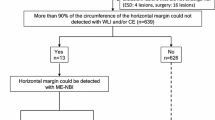Abstract
Background
The histologic evaluation of biopsy samples collected from the surrounding mucosa has conventionally been used to determine the horizontal extent of early gastric cancer. Recently, optical delineation using magnifying image-enhanced endoscopy (IEE) has been considered an alternative method to histologic evaluation. This study aimed to assess the clinical outcome and efficacy of this method in identifying cancer margins.
Methods
Overall, 921 patients with 1018 differentiated-type early gastric tumors who underwent endoscopic submucosal dissection (ESD) were examined. Before ESD, the lesions were classified based on whether they have clear or unclear margins on magnifying IEE. When the lesions had clear margins, the marking dots were placed outside the margins without a negative biopsy. Successful delineation was defined as lesions with clear margins and accurate delineation based on histopathological examination. The primary outcome was the accuracy of optical delineation without a negative biopsy compared with histopathological diagnosis. Moreover, the clinicopathological factors associated with an unsuccessful delineation were assessed.
Results
Of 1018 lesions, 820 had a clear margin and 198 an unclear margin. Of 820 lesions with a clear margin, 817 and 3 had an accurate and inaccurate delineation, respectively, according to the histological examination. Accordingly, the accuracy rate of optical delineation was 99.6% (817/820). The significant independent factors associated with an unsuccessful delineation were absence of Helicobacter pylori infection after eradication, tumor size > 20 mm, and moderate differentiation.
Conclusions
Optical delineation may be an alternative method to histological evaluation in lesions with a clear margin on magnifying IEE.





Similar content being viewed by others
References
Ono H, Kondo H, Gotoda T et al (2001) Endoscopic mucosal resection for treatment of early gastric cancer. Gut 48:225–229
Japanese Gastric Cancer Association (2018) Japanese gastric cancer treatment guidelines 2018 (5th edition). Gastric Cancer. https://doi.org/10.1007/s10120-020-01042-y
Nashimoto A, Akazawa K, Isobe Y et al (2013) Gastric cancer treated in 2002 in Japan: 2009 annual report of the JGCA nationwide registry. Gastric Cancer 16:1–27
Nagahama T, Yao K, Maki S et al (2011) Usefulness of magnifying endoscopy with narrow-band imaging for determining the horizontal extent of early gastric cancer when there is an unclear margin by chromoendoscopy (with video). Gastrointest Endosc 74:1259–1267
Suzuki H, Oda I, Sekiguchi M et al (2016) Factors associated with incomplete gastric endoscopic submucosal dissection due to misdiagnosis. Endosc Int Open 4:E788-793
Yao K, Anagnostopoulos GK, Ragunath K (2009) Magnifying endoscopy for diagnosing and delineating early gastric cancer. Endoscopy 41:462–467
Dohi O, Yagi N, Majima A et al (2017) Diagnostic ability of magnifying endoscopy with blue laser imaging for early gastric cancer: a prospective study. Gastric Cancer 20:297–303
Ezoe Y, Muto M, Uedo N et al (2011) Magnifying narrowband imaging is more accurate than conventional white-light imaging in diagnosis of gastric mucosal cancer. Gastroenterology 141:2017–2025
Kiyotoki S, Nishikawa J, Satake M et al (2010) Usefulness of magnifying endoscopy with narrow-band imaging for determining gastric tumor margin. J Gastroenterol Hepatol 25:1636–1641
Uedo N, Fujishiro M, Goda K et al (2011) Role of narrow band imaging for diagnosis of early-stage esophagogastric cancer: current consensus of experienced endoscopists in Asia-Pacific region. Dig Endosc 23:58–71
Nonaka K, Namoto M, Kitada H et al (2012) Usefulness of the DL in ME with NBI for determining the expanded area of early-stage differentiated gastric carcinoma. World J Gastrointest Endosc 4:362–367
Horii Y, Dohi O, Naito Y et al (2019) Efficacy of magnifying narrow band imaging for delineating horizontal margins of early gastric cancer. Digestion 100:93–99
Nakano T, Dohi O, Naito Y et al (2020) Efficacy and feasibility of magnifying blue laser imaging without biopsy confirmation for the diagnosis of the demarcation of gastric tumors: a randomized controlled study. Dig Dis. https://doi.org/10.1159/000510559
Nagahama T, Yao K, Uedo N et al (2018) Delineation of the extent of early gastric cancer by magnifying narrow-band imaging and chromoendoscopy: a multicenter randomized controlled trial. Endoscopy 50:566–576
Japanese Gastric Cancer Association (2011) Japanese classification of gastric carcinoma: 3rd English edition. Gastric Cancer 14:101–112
Kitamura Y, Ito M, Matsuo T et al (2014) Characteristic epithelium with low-grade atypia appears on the surface of gastric cancer after successful Helicobacter pylori eradication therapy. Helicobacter 19:289–295
47,045 gastric ESDs were performed in Japan (2014) (K→K653→150323010). https://www.mhlw.go.jp/stf/seisakunitsuite/bunya/0000139390.html
Asada-Hirayama I, Kodashima S, Sakaguchi Y et al (2016) Magnifying endoscopy with narrow-band imaging is more accurate for determination of horizontal extent of early gastric cancers than chromoendoscopy. Endosc Int Open 4:E690-698
Okamoto N, Kawachi H, Yoshida T et al (2013) “Crawling-type” adenocarcinoma of the stomach: a distinct entity preceding poorly differentiated adenocarcinoma. Gastric Cancer 16:220–232
Asada-Hirayama I, Kodashima S, Goto O et al (2013) Factors predictive of inaccurate determination of horizontal extent of intestinal-type early gastric cancers during endoscopic submucosal dissection: a retrospective analysis. Dig Endosc 25:593
Kobayashi M, Hashimoto S, Nishikura K et al (2013) Magnifying narrow-band imaging of surface maturation in early differentiated-type gastric cancers after Helicobacter pylori eradication. J Gastroenterol 48:1332–1342
Saka A, Yagi K, Nimura S (2016) Endoscopic and histological features of gastric cancers after successful Helicobacter pylori eradication therapy. Gastric Cancer 19:524–530
Author information
Authors and Affiliations
Corresponding author
Ethics declarations
Disclosures
Yoshiyasu Kitagawa, Asuka Ishigaki, Rino Nishii, Osamu Sugita, Taro Hara, and Takuto Suzuki have no conflicts of interest or financial ties to disclose.
Additional information
Publisher's Note
Springer Nature remains neutral with regard to jurisdictional claims in published maps and institutional affiliations.
Rights and permissions
About this article
Cite this article
Kitagawa, Y., Ishigaki, A., Nishii, R. et al. Clinical outcome of the delineation-without-negative-biopsy strategy in magnifying image-enhanced endoscopy for identifying the extent of differentiated-type early gastric cancer. Surg Endosc 36, 6576–6585 (2022). https://doi.org/10.1007/s00464-022-09053-9
Received:
Accepted:
Published:
Issue Date:
DOI: https://doi.org/10.1007/s00464-022-09053-9




